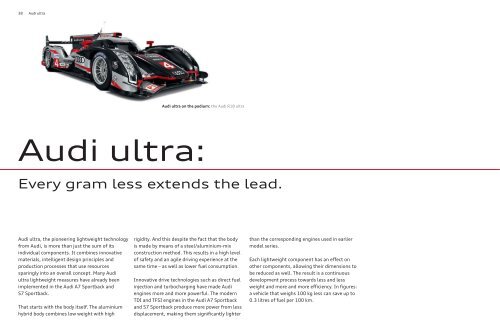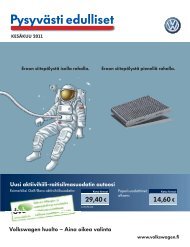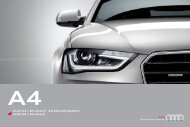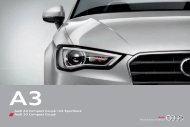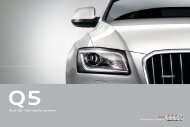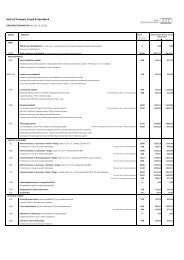Audi A7 Sportback Audi S7 Sportback
Audi A7 Sportback Audi S7 Sportback
Audi A7 Sportback Audi S7 Sportback
Create successful ePaper yourself
Turn your PDF publications into a flip-book with our unique Google optimized e-Paper software.
38 <strong>Audi</strong> ultra<br />
<strong>Audi</strong> ultra on the podium: the <strong>Audi</strong> R18 ultra<br />
<strong>Audi</strong> ultra:<br />
Every gram less extends the lead.<br />
<strong>Audi</strong> ultra, the pioneering lightweight technology<br />
from <strong>Audi</strong>, is more than just the sum of its<br />
individual components. It combines innovative<br />
materials, intelligent design principles and<br />
production processes that use resources<br />
sparingly into an overall concept. Many <strong>Audi</strong><br />
ultra lightweight measures have already been<br />
implemented in the <strong>Audi</strong> <strong>A7</strong> <strong>Sportback</strong> and<br />
<strong>S7</strong> <strong>Sportback</strong>.<br />
That starts with the body itself. The aluminium<br />
hybrid body combines low weight with high<br />
rigidity. And this despite the fact that the body<br />
is made by means of a steel/aluminium-mix<br />
construction method. This results in a high level<br />
of safety and an agile driving experience at the<br />
same time – as well as lower fuel consumption.<br />
Innovative drive technologies such as direct fuel<br />
injection and turbocharging have made <strong>Audi</strong><br />
engines more and more powerful. The modern<br />
TDI and TFSI engines in the <strong>Audi</strong> <strong>A7</strong> <strong>Sportback</strong><br />
and <strong>S7</strong> <strong>Sportback</strong> produce more power from less<br />
displacement, making them significantly lighter<br />
than the corresponding engines used in earlier<br />
model series.<br />
Each lightweight component has an effect on<br />
other components, allowing their dimensions to<br />
be reduced as well. The result is a continuous<br />
development process towards less and less<br />
weight and more and more efficiency. In figures:<br />
a vehicle that weighs 100 kg less can save up to<br />
0.3 litres of fuel per 100 km.


